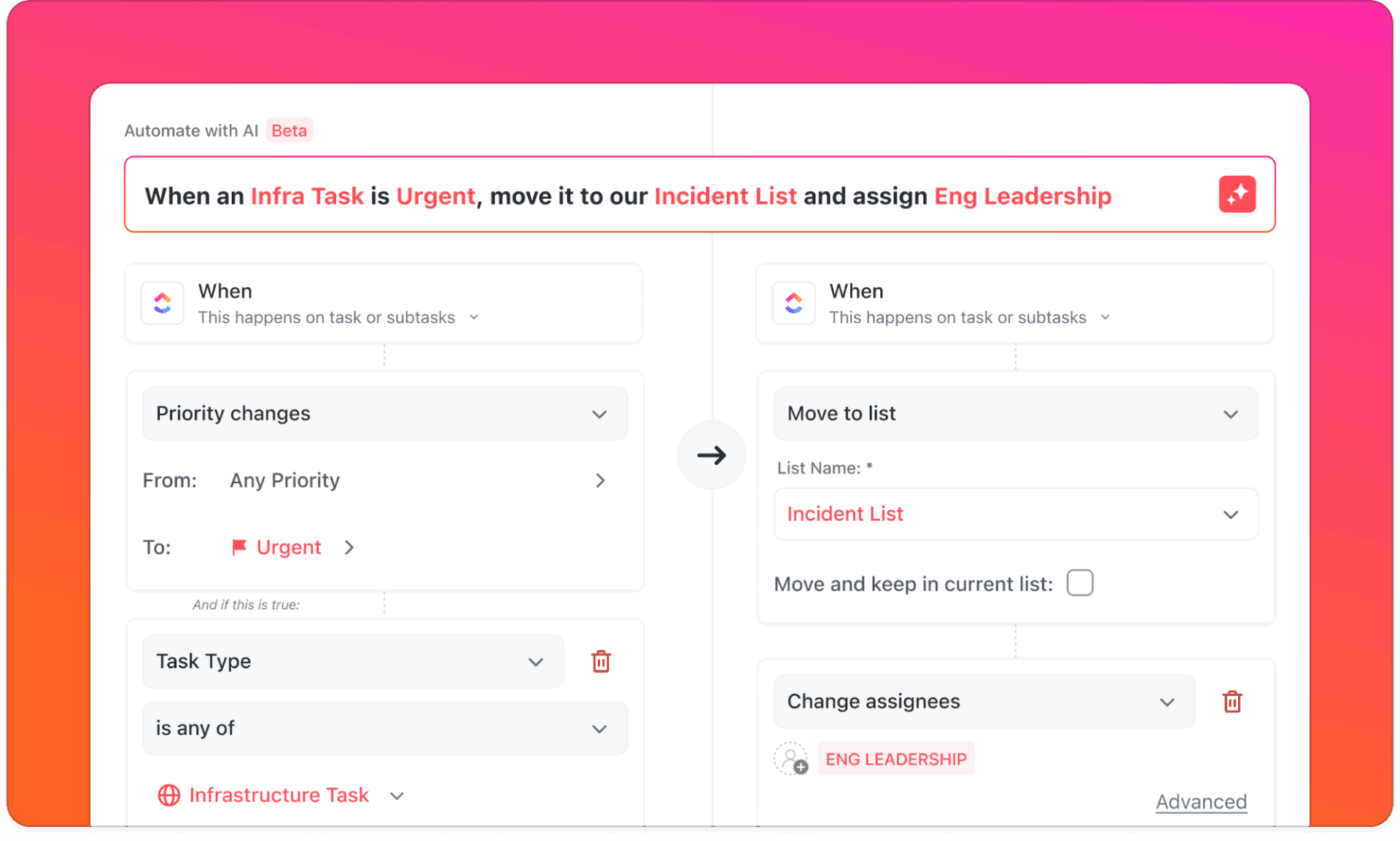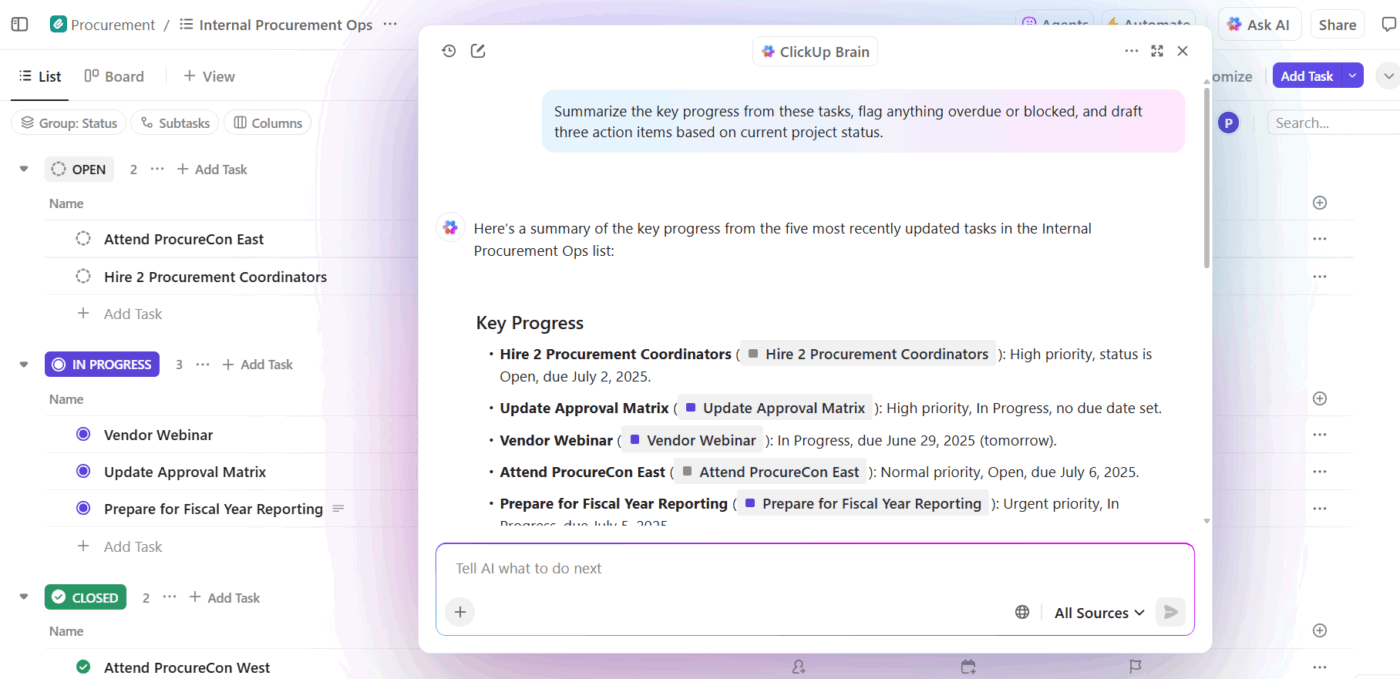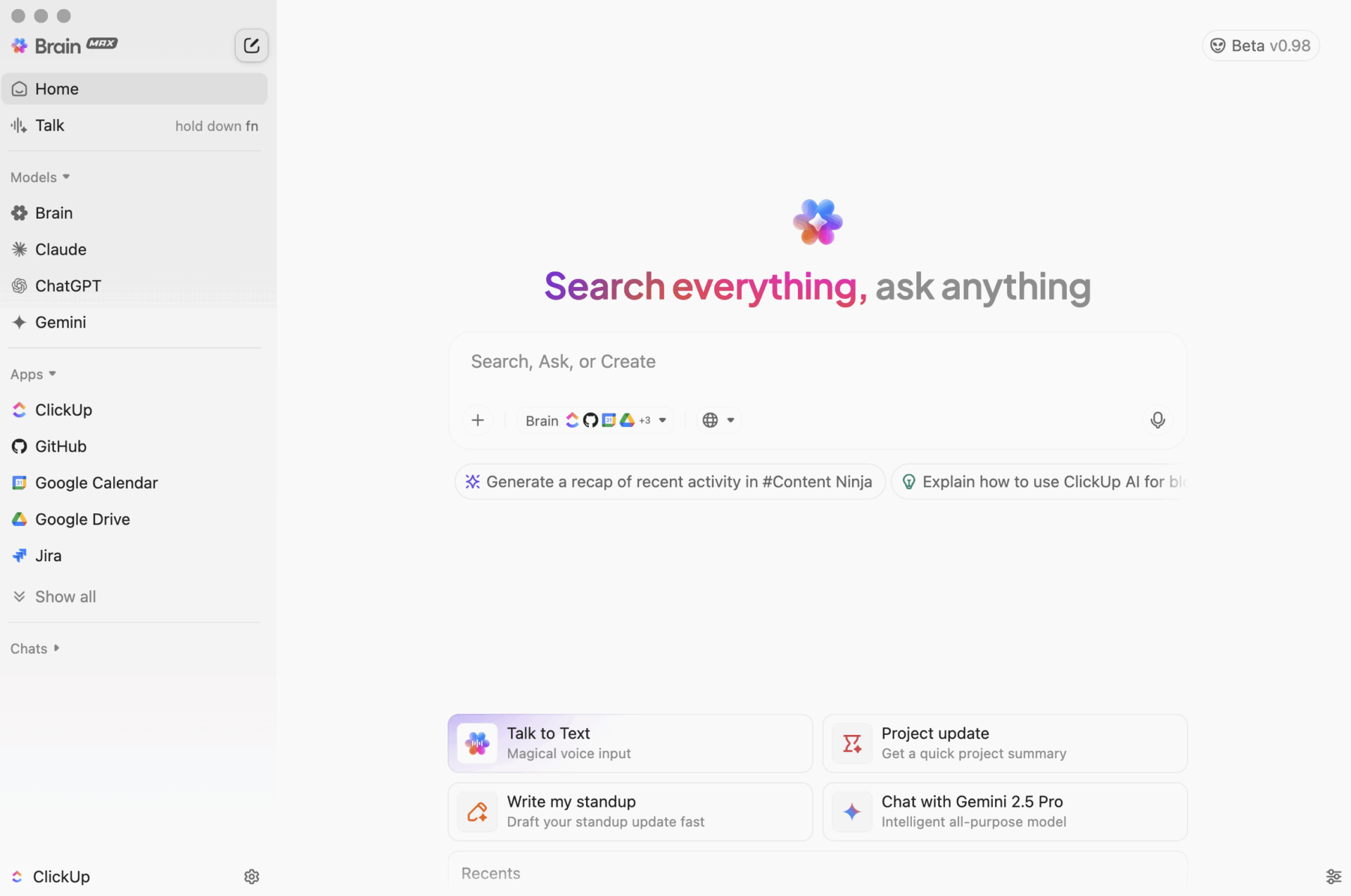How to Build AI Agents for Personal Productivity

Sorry, there were no results found for “”
Sorry, there were no results found for “”
Sorry, there were no results found for “”

Gartner predicts that agentic AI will autonomously resolve 80% of common customer service issues, cutting operational costs by nearly a third in the next few years.
This is a glimpse into the next evolution of work.
Agentic AI marks a shift to autonomy. These systems take action, canceling subscriptions, scheduling meetings, negotiating rates, and even identifying problems before you do.
And while enterprises are rethinking how they serve customers, professionals are beginning to ask a different question: how can I use this same power to serve myself?
In this blog post, we’ll explore how to build AI agents for personal productivity to help you manage busywork and keep your priorities in check. As a bonus, we look at how ClickUp, the everything app for work, can help! 🤩
AI agents for personal productivity are intelligent software entities that autonomously perform tasks and make decisions on your behalf with minimal or no continuous manual intervention.
These agents use artificial intelligence, natural language processing (NLP), and reasoning to understand user goals, connect with various applications and systems, and execute multi-step workflows independently.
Here’s how AI agents differ from traditional chatbots and automation tools:
| Feature/aspect | AI agents | Chatbots | Traditional automation tools |
| Definition | Autonomous, intelligent programs that understand context, make decisions, learn, and act proactively toward goals | Interactive programs simulating conversation, mostly reactive and guided by rule-based or AI-driven scripts | Predefined, rule-based tools that execute specific tasks automatically without learning or adaptation |
| Intelligence level | Low; responses are largely static or limited customization | Basic to intermediate AI; limited to scripted or AI-powered conversations | Low intelligence; no learning, strictly follows predefined workflows |
| Autonomy | High; can plan, execute, and adapt tasks independently | Low to moderate; responds to user inputs but does not initiate actions | None to minimal; triggered by specific events or schedules only |
| Learning ability | Continuous learning from interactions and data | Typically non-learning or limited AI learning | No learning capability |
| Complexity of tasks | Handles complex, multi-step, context-driven workflows | Handles relatively simple, structured queries or FAQs | Executes repetitive, rule-based tasks or workflows |
| Interaction mode | Multimodal (text, voice, vision) with long-term memory | Primarily text or voice, with limited session memory | No direct user interaction |
| Goal orientation | Proactive and goal-driven | Reactive and conversation-driven | Task-driven without goal or context awareness |
| Adaptability and personalization | High; adapts responses and actions to user context and behavior | Low; responses largely static or limited customization | No adaptation or personalization |
| Deployment flexibility | Multi-platform: enterprise apps, mobile, IoT, cloud systems | Websites, apps, customer service portals | Enterprise software environments, back-end systems |
| Error handling and recovery | Can recognize errors, clarify user input, and recover gracefully | Often fails or escalates to human support on unexpected inputs | Errors usually require manual intervention |
Based on recent research, here are real-life AI agent examples:
🧠 Fun Fact: A study found that when large language-model agents interact with each other, they can develop social conventions and shared language norms without human instruction. This means AI agents are creating their own ‘agentic culture.’
While the buzz around AI tools is loud, most of them still wait for your command. You prompt, they respond. An AI agent, however, goes a step further.
Let’s unpack why taking the DIY route to build an AI agent could be the smartest productivity move you make this year. 💪
📮 ClickUp Insight: 57% of people get interrupted during planned focus sessions, and 25% of those interruptions come from people. 🤦🏾♂️
But guess what? Many of these urgent questions and quick check-ins can be automated with AI Agents that can provide answers, status updates, and more.
ClickUp’s Agents can do all of that and even take care of custom workflows. Just set up the triggers, and you’re good to go!
Every effective productivity agent is built on a few essential layers to sense, think, and act on your behalf.
Let’s break down the core elements that make an AI model. ⚒️
🔍 Did You Know? Research estimates that agentic AI (which includes agents working together or independently) could unlock $450-$650 billion in additional annual revenue for advanced industries in the next five years.
Building your AI agent is a skill anybody can acquire and leverage. Here’s a simple, step-by-step path to creating your own personal productivity agent:
Start with clarity. What do you want your AI agent to handle for you? Maybe you need help managing your schedule, organizing project updates, or writing quick summaries of long chat threads.
Write down two lists: daily annoyances and repetitive tasks. That’s your starting point.
For instance, a founder might train an agent to summarize investor emails and flag urgent ones. A team manager might use it to automatically create tasks from meeting notes.
🚀 ClickUp Advantage: Set up the perfect planning hub within ClickUp Docs. You can document ideas, list out repetitive tasks, and outline potential workflows in an organized, living document. With collaborative editing, nested pages, and real-time comments, your team can refine the agent’s objectives together.
Next, pick how hands-on you want to be:
Your choice depends on time, skill, and how much control you want.
🚀 ClickUp Advantage: Set up intelligent workflows that run themselves without scripts, APIs, or integrations with ClickUp Automations. Just pick a trigger and an action, and let ClickUp handle the rest.
For instance, you could create an automation that ‘When priority changes to Urgent, assign to Team Lead and notify via chat.’ This way, you can train your AI to identify high-priority client requests.

Here are some examples of what you can automate in seconds:
This is where you plan your agent’s ‘brain’. Break it into simple parts:
Keep it modular so you can add or remove capabilities later.
📖 Also Read: Productivity Hacks and Tips
Time to give your agents some real skills:
This is where agents start to feel more like personal AI assistants than chatbots.
🧠 Fun Fact: An industry report by PwC found that 75% of executives believe AI agents will reshape the workplace more than the internet did. What’s more, 66% of firms already report productivity gains from agentic systems.
Now, let your agents work. This layer converts plans into real actions, scheduling calls, updating project boards, sending reminders, or generating summaries.
Use automation frameworks or microservices for reliability. And if you want a safety net, add approval gates (so it asks before sending that ‘end of quarter’ update to your CEO).
As time passes, your agent gets smarter. However, you have to train it. Feed it examples of your writing, workflows, and preferences. And of course, you should keep testing prompts and refining responses.
For instance, if you’re a marketer, train it to identify campaign priorities. If you’re an operations lead, teach it how to draft standard operating procedures.
In ClickUp, you can create your own AI Agents without needing to code or write extensive prompts. Unlike generic bots, ClickUp Agents are deeply embedded in your workflows. They understand context, follow logic, and collaborate with your tools in real time.

There are two ways to deploy them:
Build yours today:
We know it’s tempting, but don’t skip this part.
Run your agent through real scenarios. Ask it to plan your day, summarize a meeting, or organize a document. Watch for errors or awkward phrasing and see if it understands context correctly. The goal is reliability.
Once your agent feels ready, integrate it into your daily setup, whether on your desktop, browser, or mobile device. Use dashboards or simple monitoring tools to track performance.
🚀 ClickUp Advantage: Observe how your agent behaves in action with a real-time command center in ClickUp Dashboards. You can visualize how many tasks it created, which ones required human review, or how long it takes to complete automated actions.
Plus, AI summaries are built in!

Create cards for metrics like:
Take testing a step further with ClickUp Brain’s AI Cards. It turns raw data into quick insights. You can add cards like:

You can even customize prompts in these AI Cards, asking ClickUp Brain questions like ‘Which automated tasks were reopened by users this week?’ or ‘Summarize the key themes from feedback on AI-generated summaries.’
📖 Also Read: Best Time Management Techniques Proven To Work
ClickUp Brain is the AI-powered layer inside your workspace that connects tasks, docs, conversations, and people. You don’t have to train it on context because it already has it.
Let’s explore how it delivers value. 👇
ClickUp AI Enterprise Search taps into your complete workspace knowledge and delivers relevant answers, insights, and actions.

All you have to do is ask natural language questions about anything you need. It’ll automatically perform a deep search across tasks, docs, comments, and even connected external apps (e.g., Google Drive, OneDrive).
You save time because everything you need is at your fingertips, no context switching involved.
🔍 Did You Know? In practice, multi-agent systems are already burning through ~15× more tokens than typical chat interactions because multiple agents coordinate, share data, and execute subtasks. These systems are clearly more complex than they appear.
This part of ClickUp Brain handles project setup, updates, prioritization, and status tracking. You can use AI to automate tasks, like generating subtasks, setting dependencies, and tracking progress.
The AI Project Manager also creates summaries of tasks, updates, and items that need attention. You can even prompt it to analyze data in your workspace with suggestions to optimize it.

For instance, you can ask ClickUp Brain’s AI Project Manager to track your personal goal board. When you mark a milestone ‘done,’ it auto-launches a reflection task: ‘What’s the next goal?’ This way, you can prioritize work based on actual insights.
🧠 Fun Fact: Researchers ran a field experiment with >2,300 participants comparing human-only teams vs. human + AI-agent teams in ad creation; the human-agent teams showed 60% higher productivity per worker and spent 20% less time on editing.
ClickUp Brain’s AI Writer for Work drafts, edits, and lets you tailor copy to any context and role. You can ask it to write reports, emails, documentation, and task descriptions based on workspace context without extensive prompting.

It extracts action items and next steps from meeting notes, voice clips, chats, and documents as well. Plus, its content-ready templates help you fill in branding, tone, and role-specific format.
Suppose a marketer has just finished a campaign review call. They can ask the AI Writer to draft a ‘Campaign wrap-up email’ for stakeholders with bullet points of outcomes and next steps.
🚀 ClickUp Advantage: Only 7.2% of teams rate their AI strategy as ‘super effective’ with a strong ROI, while 44.8% of them have already abandoned AI tools adopted in the past year. The challenge most often is the very real problem of AI sprawl.
ClickUp Brain MAX eliminates this. It provides a single, unified AI-powered workspace where you can search, automate, and create across all your work tools—ending the need for multiple disconnected AI apps and making work faster, smarter, and more contextual.
You can talk to it, type to it, or let it act automatically in the background. The platform supports voice-first commands (ClickUp Talk-to-Text), multi-model AI (ChatGPT, Claude, Gemini), and cross-app automation spanning ClickUp and external tools like Google Drive, GitHub, Notion, SharePoint, and more.

You can ask AI to create, update, or search for calendar events directly within ClickUp, making it easy to schedule meetings, set reminders, or check your upcoming appointments without needing to switch apps.
ClickUp AI can also help you organize your tasks and deadlines, suggest priorities, and even automate recurring scheduling workflows.
📖 Also Read: A Guide to Using AI in Content Marketing
Let’s compare how ClickUp Brain stacks up against third-party AI agent tools:
| Feature | ClickUp Brain | Typical third-party AI agent platform |
| Deep workspace context | Embedded within your workspace. Tasks, docs, and chats automatically index them so your agent uses your real work context | Usually external, so you must integrate or upload your work data separately, and contexts may not link seamlessly with your live workflow |
| Unified platform + tools | One environment for project management, docs, tasks, and AI, with no separate login or platform required | You add an AI layer on top of existing tools, leading to more switching and fragmentation |
| No-code + built-in agent support | Comes with built-in prebuilt and custom agent capabilities, allowing you to create and manage agents directly within your workspace | May require technical setup, API connections, or external integrations to function effectively |
| Security and data control | Emphasizes enterprise-grade controls where your workspace data remains private and isn’t used to train external models | Varies widely, as some platforms reuse data for training or require additional vigilance around privacy and access |
| Workflow and task integration | You can ask questions, generate tasks, summarize docs, and update projects instantly within your workspace | Often limited to chat or basic task assistance; integrating actions into your workflow may need extra steps or tools |
| Cost and tool consolidation | Combines multiple productivity, collaboration, and AI tools into one platform, reducing costs and tool sprawl | Multiple agents usually mean separate subscriptions, scattered data, and extra management overhead |
🔍 Did You Know? Data quality has emerged as a top challenge in deploying AI agents, with 82% of executives identifying it as a major hurdle, surpassing concerns about workforce resistance or initial costs.
Here are some common errors to avoid when building AI agent tools for personal productivity:
| Common Mistakes | Solutions |
| Franken-prompting (overloading with prompts) | Use focused, modular prompt design: break down instructions into clear, non-contradictory segments. Test prompts independently and combine only once each segment is stable. |
| Giving agents too many tools | Limit tools per agent; follow a multi-agent architecture. Assign each agent a narrow scope with specialized tools. Use an orchestrator agent to delegate tasks to the appropriate agent. |
| Ignoring a clear use case definition | Start by defining clear, measurable goals tied to business or user needs. Use KPIs to track agent performance and relevancy. Map agent capabilities directly to these goals. |
| Neglecting data quality and availability | Build strong data pipelines early: data cleaning, structuring, and continuous monitoring. Prioritize diverse, high-quality datasets to reduce bias and improve real-world accuracy. |
🧠 Fun Fact: A study found that even though AI agents can tell jokes, over 90% of the jokes they generated were just repeats of the same 25 jokes, meaning they’re funny, but in the ‘kid-heard-that-once’ way.
Learning how to build AI agents for personal productivity is a mindset shift. You’re designing a digital teammate that learns your patterns, handles the busywork, and helps you focus on the work that truly matters.
While there are countless tools that you can piece together, few give you the clarity and control you need.
With ClickUp Brain and Brain MAX, you get a complete AI ecosystem that already knows how your work fits together: your projects, docs, team, and goals. You can plan, automate, create, and even talk to your workspace. Plus, you get ClickUp Agents to respond, act, and keep things moving for you.
So, what are you waiting for? Sign up to ClickUp today! ✅
AI agents operate autonomously, adapt to new situations, and make decisions in real time, learning and improving from data and interactions. On the other hand, automation follows pre-defined rules to perform repetitive tasks efficiently, but cannot adjust to unforeseen changes or scenarios.T
ClickUp Brain enables agent-like workflows by using automations, integrations, and webhooks to trigger external APIs whenever tasks or forms are updated. This lets teams create systems where AI agents or external services handle customer requests, onboarding steps, or reporting tasks without manual input.
Yes, you can create AI agents without coding experience. No-code platforms like ClickUp and others allow you to build agents using natural language instructions and drag-and-drop interfaces.
Several platforms like ClickUp, Gemini Agent Designer, HyperWrite, and Jan AI work well to build productivity-focused AI agents. ClickUp Brain offers prebuilt and customizable AI agents that automate project planning, documentation, task prioritization, and communication, making it an ideal choice for workplaces.
Security for AI agents generally relies on encryption, access controls, monitoring, and compliance with privacy regulations. ClickUp maintains strict data encryption, granular user permissions, multi-factor authentication, and audit logging.
© 2025 ClickUp